Dragons: Imagination or Instinct?
 Dragons have been an integral part of many cultures for longer than probably any of them can remember. What makes us humans so fascinated and terrified by these incredible beats? And were "dragons" merely dinosaurs whose stories were embellished with fire and horror? Could they have been inspired by something else? Do they exist in our stories because of our imaginations or an ancient instinct?First of all, we have to make sure we’re on the same page about what dragons I'm referring to here, because my go-to definition of a dragon may be different than yours. The focus of this post is what some have referred to as the European dragon. This is a giant lizard with four legs (not a wyvern) and a pair of large wings, usually capable of breathing fire. This dragon is pretty much always represented as a villain in old literature, and only in the last several decades has it been more commonly represented as a good character. (If the Chinese version of a dragon is more you’re type, you may be interested in this post comparing the European dragon and the Chinese dragon, as there is more history and description of them there.)
Dragons have been an integral part of many cultures for longer than probably any of them can remember. What makes us humans so fascinated and terrified by these incredible beats? And were "dragons" merely dinosaurs whose stories were embellished with fire and horror? Could they have been inspired by something else? Do they exist in our stories because of our imaginations or an ancient instinct?First of all, we have to make sure we’re on the same page about what dragons I'm referring to here, because my go-to definition of a dragon may be different than yours. The focus of this post is what some have referred to as the European dragon. This is a giant lizard with four legs (not a wyvern) and a pair of large wings, usually capable of breathing fire. This dragon is pretty much always represented as a villain in old literature, and only in the last several decades has it been more commonly represented as a good character. (If the Chinese version of a dragon is more you’re type, you may be interested in this post comparing the European dragon and the Chinese dragon, as there is more history and description of them there.)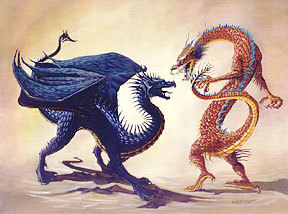 So the European dragon. Could it be a dinosaur with wings? Or an ancient instinct that’s been growing in us humans for generations?Let’s start with the dinosaur theory: Did the idea of dragons come from dinosaurs?We know there were some dinosaurs with wings: pterosaurs such as pterodactyls, pteranodons, etc. but nothing that really resembles our image of the Smaug-like animal.Perhaps the one that comes the closest to the European dragon ideal—at least size-wise—is Quetzalcoatlus northropi, the largest pterosaur ever found. It stood as tall as a giraffe and had a wingspan of thirty-six feet.But what about the fire breathing stuff? Where might that have come from if the idea of dragons came from dinosaurs?
So the European dragon. Could it be a dinosaur with wings? Or an ancient instinct that’s been growing in us humans for generations?Let’s start with the dinosaur theory: Did the idea of dragons come from dinosaurs?We know there were some dinosaurs with wings: pterosaurs such as pterodactyls, pteranodons, etc. but nothing that really resembles our image of the Smaug-like animal.Perhaps the one that comes the closest to the European dragon ideal—at least size-wise—is Quetzalcoatlus northropi, the largest pterosaur ever found. It stood as tall as a giraffe and had a wingspan of thirty-six feet.But what about the fire breathing stuff? Where might that have come from if the idea of dragons came from dinosaurs? One possibility is a certain ancient beast called Leviathan, a fearsome creature described in the Bible.
One possibility is a certain ancient beast called Leviathan, a fearsome creature described in the Bible.  There are several skeletons of different species of dinosaurs that may fit the description, particularly Sarcosuchus. I’ve written another post on that one, so I wont rehash it all, but the point here is that one of the particular types of skeletons that may fit the description of Leviathan, in fact, the one that is most likely to be the Leviathan, has a hollow place in the end of his nose.
There are several skeletons of different species of dinosaurs that may fit the description, particularly Sarcosuchus. I’ve written another post on that one, so I wont rehash it all, but the point here is that one of the particular types of skeletons that may fit the description of Leviathan, in fact, the one that is most likely to be the Leviathan, has a hollow place in the end of his nose.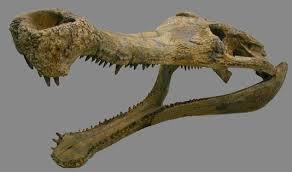 Why is a hollow bit of snoot important?Paleontologists speculate that this hollow place may have been used to mix chemicals that could result in something like fire. The bombardier beetle’s unique defense mechanism is a great example of this idea.
Why is a hollow bit of snoot important?Paleontologists speculate that this hollow place may have been used to mix chemicals that could result in something like fire. The bombardier beetle’s unique defense mechanism is a great example of this idea. 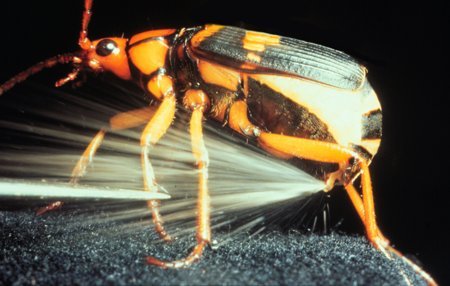 When startled, the beetle mixes two chemicals in its abdomen and shoots the combination out at a predator. The chemical mixture looks more like water than fire, but it comes out at boiling temperature at over twenty miles per hour. And the space in Leviathan’s nose is much bigger than the little space in the bombardier beetle’s bum.Likelihood? I'd like to think so.Here’s another interesting theory.One person who read my last post on dragons shared a book with me on the topic. The book was written by his uncle, David E. Jones, about a very interesting theory of the origin of the idea of dragons. The description sounded so intriguing that I bought a copy and read it in a couple of days. This was in the very early days of my blog before I had the Disqus comments feature, so unfortunately my whole conversation with the man who recommended the book to me was lost and I can’t remember his name.
When startled, the beetle mixes two chemicals in its abdomen and shoots the combination out at a predator. The chemical mixture looks more like water than fire, but it comes out at boiling temperature at over twenty miles per hour. And the space in Leviathan’s nose is much bigger than the little space in the bombardier beetle’s bum.Likelihood? I'd like to think so.Here’s another interesting theory.One person who read my last post on dragons shared a book with me on the topic. The book was written by his uncle, David E. Jones, about a very interesting theory of the origin of the idea of dragons. The description sounded so intriguing that I bought a copy and read it in a couple of days. This was in the very early days of my blog before I had the Disqus comments feature, so unfortunately my whole conversation with the man who recommended the book to me was lost and I can’t remember his name.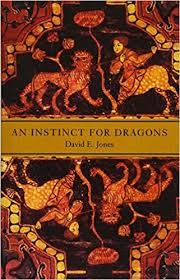 In his book, An Instinct for Dragons, Jones begins with the vervet monkey from Africa. These little creatures employ a very unique safety protocol amongst themselves. They have three main predators: pythons, eagles and panthers. And for each of these dangers, they have a distinct distress call. When a vervet notices one of those predators is near, it will sound the alarm and the rest of the group will join in as well.
In his book, An Instinct for Dragons, Jones begins with the vervet monkey from Africa. These little creatures employ a very unique safety protocol amongst themselves. They have three main predators: pythons, eagles and panthers. And for each of these dangers, they have a distinct distress call. When a vervet notices one of those predators is near, it will sound the alarm and the rest of the group will join in as well.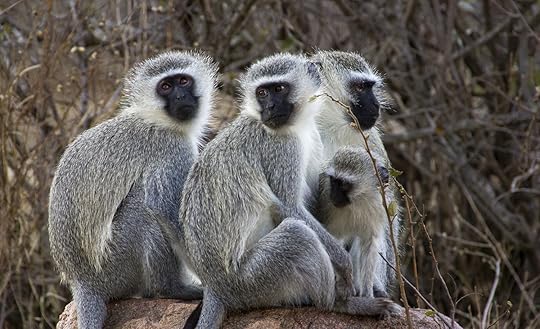 And based on which distinct call it is, they all know where to go. If it’s an alert for an eagle, they know to go further down in the trees where an eagle can’t fly to. If it’s an alarm for a panther or a python, they know to head for the highest branches where those heavier predators can’t reach.What does this have to do with dragons?If you take a look at a lot of ancient depictions of dragon like-creatures, you can see certain elements occurring consistently. Many have the back feet of a large cat, and the front feet of an eagle plus or minus wings. They also usually have a tail, and frequently a serpentine face. As I mention in that other post about Chinese dragons, if you look at one of those, it’s not based on a lizard at all, but a mix of several different animals, each representing some valued quality.So say that our interest in and fear of dragons isn’t based on dinosaurs, but on a prehistoric instinct to fear those three main predators? What if our minds blended all three of them into one terrifying monster?Jones proposes that as humans evolved from primates (which is not my personal belief) we evolved with the fear of those three main predators and as time went on, they became one thing in our minds and we fear them now because we feared the original predators when we were monkeys.I personally am a believer in creation, not evolution, but I am really intrigued by this idea. There are a lot of interesting things a writer could do with it in development of a world and the people in it.So what do you think? Did our fear and morbid curiosity about dragons come from dinosaurs imagined embellishments of dinosaurs, primordial instinct, or something else? Was there ever a real fire breathing dragon in our world? Feel free to share in the comments!In Recent MediaMy all-time favorite dragon series is the Inheritance Cycle by Christopher Paolini. Yes, his writing style in the first book has room for improvement. No, that does not reduce my love of this series. He wrote Eragon when he was fifteen! Let’s give him a break. It’s basically the best story ever.
And based on which distinct call it is, they all know where to go. If it’s an alert for an eagle, they know to go further down in the trees where an eagle can’t fly to. If it’s an alarm for a panther or a python, they know to head for the highest branches where those heavier predators can’t reach.What does this have to do with dragons?If you take a look at a lot of ancient depictions of dragon like-creatures, you can see certain elements occurring consistently. Many have the back feet of a large cat, and the front feet of an eagle plus or minus wings. They also usually have a tail, and frequently a serpentine face. As I mention in that other post about Chinese dragons, if you look at one of those, it’s not based on a lizard at all, but a mix of several different animals, each representing some valued quality.So say that our interest in and fear of dragons isn’t based on dinosaurs, but on a prehistoric instinct to fear those three main predators? What if our minds blended all three of them into one terrifying monster?Jones proposes that as humans evolved from primates (which is not my personal belief) we evolved with the fear of those three main predators and as time went on, they became one thing in our minds and we fear them now because we feared the original predators when we were monkeys.I personally am a believer in creation, not evolution, but I am really intrigued by this idea. There are a lot of interesting things a writer could do with it in development of a world and the people in it.So what do you think? Did our fear and morbid curiosity about dragons come from dinosaurs imagined embellishments of dinosaurs, primordial instinct, or something else? Was there ever a real fire breathing dragon in our world? Feel free to share in the comments!In Recent MediaMy all-time favorite dragon series is the Inheritance Cycle by Christopher Paolini. Yes, his writing style in the first book has room for improvement. No, that does not reduce my love of this series. He wrote Eragon when he was fifteen! Let’s give him a break. It’s basically the best story ever.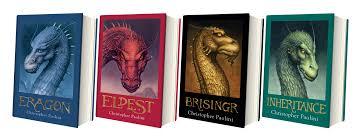 Ann McCaffery’s Dragon Riders of Pern series is excellent as well. I have to admit I haven’t read the whole series yet at this point, but I plan to and have thoroughly enjoyed the three I have read so far.
Ann McCaffery’s Dragon Riders of Pern series is excellent as well. I have to admit I haven’t read the whole series yet at this point, but I plan to and have thoroughly enjoyed the three I have read so far. A Natural History of Dragons, by Marie Brennan, has the best covers out of the three series mentioned here. The cover of the first book won me over because it’s just such a well-done blend of a fantastical dragon and the realistic-looking textbook anatomy illustration. Being in the veterinary field also could have affected my admiration of this cover.
A Natural History of Dragons, by Marie Brennan, has the best covers out of the three series mentioned here. The cover of the first book won me over because it’s just such a well-done blend of a fantastical dragon and the realistic-looking textbook anatomy illustration. Being in the veterinary field also could have affected my admiration of this cover.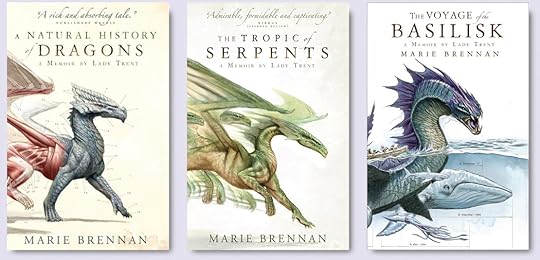 What dragon series is your favorite? Do you prefer dragons on the good side or the dark side, or both? Do you like sentient dragons? Or do you think they are better with just animal level intelligence?Creative CornerFor writers of dragony things (or really any type of things), what do you think of David E. Jones’s theory? Whether you agree or disagree with its validity, think of the things you could do with it in a story! There are tons of world building possibilities there. Maybe the protagonist is terrified of something that no one else recognizes as a threat, because she inherited some ancient primal awareness of that particular danger, and somehow she is the only one with such an ability. Should she listen to her gut and do something drastic, or follow the status quo and push down her instincts?Or what if the protagonist comes across a group of people who all have some kind of instinctive fear of him, because of some misunderstanding that happened between their two kinds a millennia ago? Perhaps he’ll need to give up his home in order to protect it and win the trust of these people before some major war breaks out, or perhaps he’ll need to escape their clutches in order to warn his own people that these other people are coming for them because of something that happened so long ago no one even knows.What other ideas could you come up with, whether about dragons or any other creatures? Feel free to share in the comments!
What dragon series is your favorite? Do you prefer dragons on the good side or the dark side, or both? Do you like sentient dragons? Or do you think they are better with just animal level intelligence?Creative CornerFor writers of dragony things (or really any type of things), what do you think of David E. Jones’s theory? Whether you agree or disagree with its validity, think of the things you could do with it in a story! There are tons of world building possibilities there. Maybe the protagonist is terrified of something that no one else recognizes as a threat, because she inherited some ancient primal awareness of that particular danger, and somehow she is the only one with such an ability. Should she listen to her gut and do something drastic, or follow the status quo and push down her instincts?Or what if the protagonist comes across a group of people who all have some kind of instinctive fear of him, because of some misunderstanding that happened between their two kinds a millennia ago? Perhaps he’ll need to give up his home in order to protect it and win the trust of these people before some major war breaks out, or perhaps he’ll need to escape their clutches in order to warn his own people that these other people are coming for them because of something that happened so long ago no one even knows.What other ideas could you come up with, whether about dragons or any other creatures? Feel free to share in the comments!
Published on May 02, 2018 12:34
No comments have been added yet.



